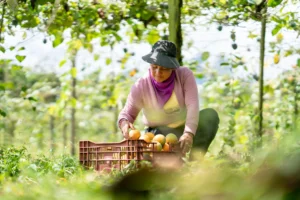Written by Erik Federman, Spring 2017 student in the Food Law and Policy Clinic.
“Food has been used as a weapon against the Navajo Nation.”
With those words, Amber Crotty, a delegate to the Navajo Nation Council, began her closing remarks for the Diné Bich’iya (Navajo Food Sovereignty) Summit. “We’re in the remembering phase,” she continued; the Navajo people have to reconnect with their traditional food ways. The Food Law and Policy Clinic had flown me and my teammate, Katie, and our supervisor, Christina, to Arizona, so that we could attend the summit. All semester, we had been studying the 2014 Farm Bill, to see how the programs authorized by it could be used, or altered, to help the Navajo Nation regain control over its food system.
Regions of the Navajo Nation have obesity rates ranging from 23-60 percent, and 25 percent of people living on the reservation, which stretches across New Mexico, Arizona, and Utah, are diabetic. There’s a lot of fast food, and few grocery stores. Hot Cheetos are the best selling snack across the reservation. Traditional foods and other healthy foods are harder to come by than highly processed alternatives, and are far more expensive. At the same time, Navajo farmers face barriers gaining access to land and water, and a lack of infrastructure makes it difficult for them to bring their products to market.
Local advocates have risen to face these challenges, and are working to achieve food sovereignty for the Navajo Nation. As a part of this effort, Navajo Vice President Jonathan Nez sponsored the Diné Bich’iya Summit to create an opportunity for stakeholders to come together, identify issues facing the Navajo food system, and brainstorm solutions.
The summit ran for three days. Christina, Katie, and I spent them flitting from one break out session to another, trying to soak up as much information as we could. We heard from Navajo politicians, like Council Delegate Crotty and Vice President Nez, community organizers, public health professionals, botanists, farmers, and anyone else interested in the Navajo food system. It was exciting to be around so many motivated people eager to make a change. We learned a lot, too!
We weren’t just there to listen, though, and Katie and I spoke at a breakout session on the second day. We presented a food policy toolkit that the Clinic had put together in 2015 (Putting Food Policy to Work in Navajo Nation) and the Clinic’s 2016 report on how to expand farm to school in Navajo Nation (Growing Farm to School Programs on the Navajo Nation). We were joined by two exceptional women, our host, Sonlatsa Jim-Martin of Community Outreach and Patient Empowerment, and Pam Roy, of New Mexico Farm to Table.
Although the summit kept us plenty busy, we still found time to enjoy its setting. We stayed in Chinle, Arizona, which sits right at the lip of the Canyon de Chelly – a deep, dramatic canyon that native peoples have called home for millennia. We hiked to the canyon floor one evening, where the sunset bathed the sheer sandstone walls in golden light. We’d gotten selfie-sticks in our welcome bags at the summit, and they got plenty of use.

It was a privilege to work on this project and to travel to Navajo Nation. I met so many amazing people there, and learned so much about the challenges they face and the work they’re doing to overcome them. It was an inspirational experience, and one I won’t soon forget.


Food Law & Policy, Commentary
Policy to Reduce Methane Emissions and Feed More People
April 3, 2025